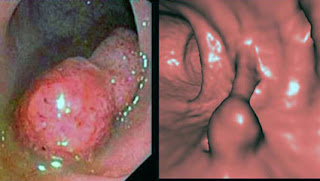Virtual Colonoscopy: an appealing alternative
 Medical imaging modalities such as CT and MRI scans can be combined to produce incredible 3D images of human anatomy. The technology is improving everyday and images are becoming easier to work with. One area where medical imaging has the opportunity to help saves lives is in the colon. Virtual colonoscopy is a relatively new and upcoming way to effectively screen for colon cancer.What is Virtual Colonoscopy?
Medical imaging modalities such as CT and MRI scans can be combined to produce incredible 3D images of human anatomy. The technology is improving everyday and images are becoming easier to work with. One area where medical imaging has the opportunity to help saves lives is in the colon. Virtual colonoscopy is a relatively new and upcoming way to effectively screen for colon cancer.What is Virtual Colonoscopy? Virtual Colonoscopy (VC) combines detailed imaging technology (MRI and CT scans) with advanced graphics software to make exquisite, highly accurate 3D images of the inside of your colon. Doctors can then "fly" through the colon to explore areas of cancer without the need for a conventional colonoscopy. The result is a set of images that provide a radiologist with essentially the same sort of view of the colon, as a gastroenterologist would have by doing a regular colonoscopy. VC is able to accurately detect polyps 10mm in diameter. The advantages really have to do with the fact that the technique is relatively quick, fairly sensitive, and only minimally invasive.Why is it Important?Colon cancer is the second leading cause of cancer deaths (after lung cancer) in the United States. I don't think many people realize just how prevalent it is. What may strike most people, however, is just how preventable colon cancer really is. If cancerous growths are detected early, patients have a 90% chance of surviving. Unfortunately, relatively few people undergo colonoscopies. This can be life threatening because many individuals with colon cancer have no symptoms until the disease reaches an advanced. Cancer screening can find dangerous polyps (abnormal growths in the colon or rectum) so that they can be removed before turning into cancer. From a public health perspective, virtual colonoscopy could save many lives.How is it performed?Unfortunately you are still required to take laxatives or other oral agents at home a day or two before the procedure to clear stool from your colon. They're actually working to improve VC so that stool can simply be "deleted" or ignored in the 3D images.So, the doctor will ask you to lie on your back on a table. A thin tube will be carefully inserted into your rectum, and air will be pumped through the tube to inflate the colon for better viewing.The table moves through the scanner to produce a series of two-dimensional cross-sections along the length of the colon. The scan takes about 10 minutes and you will be asked to hold your breath for a short while during the scan so that the images won"t be distorted through movement.
Virtual Colonoscopy (VC) combines detailed imaging technology (MRI and CT scans) with advanced graphics software to make exquisite, highly accurate 3D images of the inside of your colon. Doctors can then "fly" through the colon to explore areas of cancer without the need for a conventional colonoscopy. The result is a set of images that provide a radiologist with essentially the same sort of view of the colon, as a gastroenterologist would have by doing a regular colonoscopy. VC is able to accurately detect polyps 10mm in diameter. The advantages really have to do with the fact that the technique is relatively quick, fairly sensitive, and only minimally invasive.Why is it Important?Colon cancer is the second leading cause of cancer deaths (after lung cancer) in the United States. I don't think many people realize just how prevalent it is. What may strike most people, however, is just how preventable colon cancer really is. If cancerous growths are detected early, patients have a 90% chance of surviving. Unfortunately, relatively few people undergo colonoscopies. This can be life threatening because many individuals with colon cancer have no symptoms until the disease reaches an advanced. Cancer screening can find dangerous polyps (abnormal growths in the colon or rectum) so that they can be removed before turning into cancer. From a public health perspective, virtual colonoscopy could save many lives.How is it performed?Unfortunately you are still required to take laxatives or other oral agents at home a day or two before the procedure to clear stool from your colon. They're actually working to improve VC so that stool can simply be "deleted" or ignored in the 3D images.So, the doctor will ask you to lie on your back on a table. A thin tube will be carefully inserted into your rectum, and air will be pumped through the tube to inflate the colon for better viewing.The table moves through the scanner to produce a series of two-dimensional cross-sections along the length of the colon. The scan takes about 10 minutes and you will be asked to hold your breath for a short while during the scan so that the images won"t be distorted through movement. After the exam, the information from the scanner must be processed to compose the series of 2D cross-sections into a 3D image of your colon. A radiologist will then evaluate the results to identify any abnormalities.AdvantagesVC is obviously more comfortable than conventional colonoscopy because it does not use an invasive colonoscope. Real colonoscopies are uncomfortable and run the risk of perforating the wall of the colon, putting the patient at risk of a deadly infection. It is also unable to see the entire colon in 1 out of 10 people. No sedation is needed and you can return to your usual activities or go home after the procedure without the aid of another person. VC takes less time than either a conventional colonoscopy or a lower GI series.
After the exam, the information from the scanner must be processed to compose the series of 2D cross-sections into a 3D image of your colon. A radiologist will then evaluate the results to identify any abnormalities.AdvantagesVC is obviously more comfortable than conventional colonoscopy because it does not use an invasive colonoscope. Real colonoscopies are uncomfortable and run the risk of perforating the wall of the colon, putting the patient at risk of a deadly infection. It is also unable to see the entire colon in 1 out of 10 people. No sedation is needed and you can return to your usual activities or go home after the procedure without the aid of another person. VC takes less time than either a conventional colonoscopy or a lower GI series. DisadvantagesThe doctor cannot take tissue samples or remove polyps during VC, so a conventional colonoscopy must be performed anyway if polyps are found. VC does not show as much detail as a conventional colonoscopy, so polyps smaller than 10mm in diameter may not show up in the 3D image.Get ScreenedAny invasive procedure can be dangerous so you want to have a colonoscopy only when you actually need to operate or remove a polyp, rather than just for routine screening. A colonoscopy is not a procedure anyone looks forward to having performed. But, guidelines indicate everyone should be screened beginning at age 50. Unfortunately, many people choose to postpone this important test until symptoms force them to seek help. Virtual Colonoscopy provides an appealing alternative to conventional colonoscopy, which will hopefully encourage more people to be screened, because colon cancer doesn't have to be the second leading cause of cancer deaths in the U.S.And with that, here;s a poster I designed to help get people motivated.
DisadvantagesThe doctor cannot take tissue samples or remove polyps during VC, so a conventional colonoscopy must be performed anyway if polyps are found. VC does not show as much detail as a conventional colonoscopy, so polyps smaller than 10mm in diameter may not show up in the 3D image.Get ScreenedAny invasive procedure can be dangerous so you want to have a colonoscopy only when you actually need to operate or remove a polyp, rather than just for routine screening. A colonoscopy is not a procedure anyone looks forward to having performed. But, guidelines indicate everyone should be screened beginning at age 50. Unfortunately, many people choose to postpone this important test until symptoms force them to seek help. Virtual Colonoscopy provides an appealing alternative to conventional colonoscopy, which will hopefully encourage more people to be screened, because colon cancer doesn't have to be the second leading cause of cancer deaths in the U.S.And with that, here;s a poster I designed to help get people motivated.
